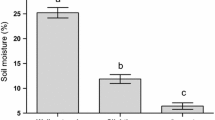Abstract
Carneocephala floridana, an oligophagous leafhopper that inhabits the salt marshes along the coasts of Florida, utilizesBorrichia frutescens andSalicornia virginica (both herbs) as primary summer hosts, but uses two grasses,Distichlis spicata andSpartina alterniflora, during the winter. We tested whether the seasonal patterns of abundance and apparent host-switching byCarneocephala are related to plant quality. In laboratory experiments, nymphs ofCarneocephala reared on nonfertilized control plants of the two herbs produced adults that were similar in size to field-collected insects. OnlyCarneocephala raised at the lowest densities onSpartina andDistichlis from the highest fertilizer treatments produced adults similar in body mass to those reared on nonfertilizedBorrichia andSalicornia. ForDistichlis, superior quality (high foliar nitrogen) plants were able to mitigate the negative effect of nymphal crowding on adult body mass. However, laboratory fertilization regimes produced an extremely high foliar nitrogen content in the two herbs and the organic acid concentration in the xylem fluid ofBorrichia, the only host species suitable for xylem fluid extraction, increased 2.5- to 3-fold. Total amino acid concentration in the xylem fluid of fertilizedBorrichia decreased compared to nonfertilized plants.Carneocephala demonstrated reduced feeding efficiencies on high nitrogenBorrichia. Our results suggest thatCarneocephala prefers, and performs better on, plants with high nitrogen content up to a threshold, beyond which high nitrogen levels result in reduced leafhopper feeding rates and assimilation efficiencies.
Similar content being viewed by others
References
Andersen, P. C., andBrodbeck, B. V. 1989. Diurnal and temporal changes in the chemical profile of xylem exudate fromVitis rotundifolia.Physiol. Plant. 75:63–70.
Andersen, P. C., Brodbeck, B. V., andMizell, R. F., III. 1989. Metabolism of amino acids, organic acids, and sugars extracted from the xylem fluid of four host plants by adultHomalodisca coagulata.Entomol. Exp. Appl. 50:149–159.
Backus, E. A. 1985. Anatomical and sensory mechanisms of leafhopper and planthopper feeding behavior, pp. 163–194,in L. R. Nault and J. G. Rodriguez (eds.). The Leafhoppers and Planthoppers. John Wiley & Sons, New York.
Ball, E. D. 1927. The genusDraeculacephala and its allies in North America (Rhynchota Homoptera).Fla. Entomol. 11:33–40.
Brodbeck, B. V., andStrong, D. R. 1987. Amino acid nutrition of herbivorous insects and stress to host plants, pp. 347–364,in P. Barbosa and J. Schultz (eds.). Outbreaks of Insect Pests. Academic Press, New York.
Brodbeck, B. V., Mizell, R. F., III, French, W. J., andAndersen, P. C. 1990. Amino acids as determinants of host preference for the xylem feeding leafhopper,Homalodisca coagulata (Homoptera: Cicadellidae).Oecologia 83:338–345.
Brodbeck, B. V., Mizell, R. F., III, andAndersen, P. C. 1993. Physiological and behavioral adaptations of three species of leafhoppers in response to the dilute nutrient content of xylem fluid.J. Insect Physiol. 39:73–81.
Denno, R. F., Douglass, L. W., andJacobs, D. 1986. Effects of crowding and host plant nutrition on a wing-dimorphic planthopper.Ecology 67:116–123.
Dorschner, K. W., Ryan, J. D., Johnson, R. C., andEikenbary, R. D. 1987. Modification of host nitrogen levels by the greenbug (Homoptera: Aphididae): Its role in resistance of winter wheat to aphids.Environ. Entomol. 16:1007–1011.
Feeny, P. 1970. Seasonal changes in oak leaf tannins and nutrients as a cause of spring feeding by winter moth caterpillars.Ecology 51:565–581.
Heinrickson, R. W., andMeredith, S. C. 1984. Amino acid analysis by reverse phase high performance liquid chromatography: Precolumn derivatization with phenylisothiocyanate.Anal. Biochem. 136:65–74.
Mattson, W. J., Jr. 1980. Herbivory in relation to plant nitrogen content.Annu. Rev. Ecol. Syst. 11:119–161.
McKey, D. 1979. The distribution of secondary compounds within plants, pp. 55–133,in G. A. Rosenthal and D. H. Janzen (eds.). Herbivores: Their Interaction with Plant Secondary Metabolites. Academic Press, New York.
McNeill, S., andSouthwood, T. R. E. 1978. The role of nitrogen in the development of insect/plant relationships, pp. 77–98,in J. B. Harborne (ed.). Biochemical Aspects of Plant and Animal Coevolutions. Academic Press, London.
Mittler, T. E. 1957. Studies on the feeding and nutrition ofTuberolachnus salignus (Gmelin) (Homoptera: Aphididae) II. The nitrogen and sugar composition of ingested phloem sap and excreted honeydew.Exp. Biol. 35:74–84.
Nottingham, J. O. 1932. The genusCarneocephala (Homoptera: Cicadellidae).J. Kans. Entomol. Soc. 5:97–115.
Petersen, R. G. 1985. Design and Analysis of Experiments. Marcel Dekker, New York.
Reese, J. C. 1979. Interactions of allelochemicals with nutrients in herbivore food, pp. 309–320,in G. A. Rosenthal and D. H. Janzen (eds.). Herbivores: Their Interaction with Secondary Plant Metabolites. Academic Press, New York.
Rossi, A. M. 1991. The factors influencing host plant preference and performance of the leafhopperCarneocephala floridana (Homoptera: Cicadellidae). PhD dissertation. Florida State University, Tallahassee, Florida.
Rossi, A. M., andStrong, D. R. 1990. Natural history of the leafhopperCarneocephala floridana (Homoptera: Cicadellidae) in a north Florida salt marsh.Fla. Entomol. 73:147–153.
Rossi, A. M., andStrong, D. R. 1991. Effects of host-plant nitrogen on the preference and performance of laboratory populations ofCarneocephala floridana (Homoptera: Cicadellidae).Environ. Entomol. 20:1349–1355.
Rossi, A. M., Stiling, P. D., Strong, D. R., andJohnson, D. M. 1992. Does gall diameter affect the parasitism rate ofAsphondylia borrichiae (Diptera: Cecidomyiidae).Ecol. Entomol. 17:149–154.
Rossi, A. M., Reeve, J. D., andCronin, J. T. 1994. The effect of plant- and parasitoid-induced egg mortality on the interspecific distribution of an oligophagous herbivore.Oecologia 100:89–93.
Salisbury, F. B., andRoss, C. W. 1985. Plant Physiology, 3rd ed. Wadsworth Publishing, Belmont, California, pp. 284–285.
Scholander, P. F., Bradstreet, E. D., Hammell, M. T., andHemmingsen, E. A. 1965. Sap pressure in vascular plants.Science 148:339–346.
Sogawa, K. 1982. The rice brown planthopper: Feeding physiology and host plant interactions.Annu. Rev. Entomol. 27:49–73.
Sokal, R. R., andRohlf, F. J. 1969. Biometry. W. H. Freeman, San Francisco.
Strong, D. R., Lawton, J. H., andSouthwood, R. 1984. Insects on Plants. Harvard University Press, Cambridge, Mass.
Turkelson, V. T., andRichards, M. 1978. Separation of citric acids by liquid chromatography.J. Anal. Chem. 50:1420–1423.
Author information
Authors and Affiliations
Rights and permissions
About this article
Cite this article
Rossi, A.M., Brodbeck, B.V. & Strong, D.R. Response of xylem-feeding leafhopper to host plant species and plant quality. J Chem Ecol 22, 653–671 (1996). https://doi.org/10.1007/BF02033576
Received:
Accepted:
Issue Date:
DOI: https://doi.org/10.1007/BF02033576




